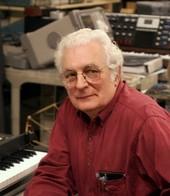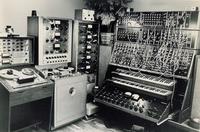In Memory of Robert Moog
 True propellerheads will always have a special place in their hearts for the original modular Moogs the way an old space flight fanatic might yearn for the sight of the Apollo spacecraft. I will never forget how I learned about the fundamentals of musical sounds while working with a Moog 55 in college. The modular design meant that I was able to understand exactly what was happening to each note at each stage of the synthesis process.
True propellerheads will always have a special place in their hearts for the original modular Moogs the way an old space flight fanatic might yearn for the sight of the Apollo spacecraft. I will never forget how I learned about the fundamentals of musical sounds while working with a Moog 55 in college. The modular design meant that I was able to understand exactly what was happening to each note at each stage of the synthesis process.The NYT obit does a good job of describing the Moog's basic modules:
The first Moog synthesizers were collections of modules, connected by electronic patch cords, something like those that connect stereo components. The first module, an oscillator, would produce a sound wave, giving a musician a choice of several kinds, ranging from the gracefully undulating purity of a sine wave to the more complex, angular or abrasive sounds of square and sawtooth waves. The wave was sent to the next module, called an A.D.S.R. (attack-decay-sustain-release) envelope generator, with which the player defined the way a note begins and ends, and how long it is held. A note might, for example, explode in a sudden burst, like a trumpet blast, or it could fade in at any number of speeds. From there, the sound went to a third module, a filter, which was used to shape its color and texture.
 Analog synths have long since been overtaken by digital machines. But Moog Music still sells versions of the Minimoog, and software versions that emulate its classic sound are available for digital recording systems like Pro Tools. If you Google "analog synth" you will find a wealth of information about what I think of as the original instrument movement of electronic music.
Analog synths have long since been overtaken by digital machines. But Moog Music still sells versions of the Minimoog, and software versions that emulate its classic sound are available for digital recording systems like Pro Tools. If you Google "analog synth" you will find a wealth of information about what I think of as the original instrument movement of electronic music.


0 Comments:
Post a Comment
<< Home